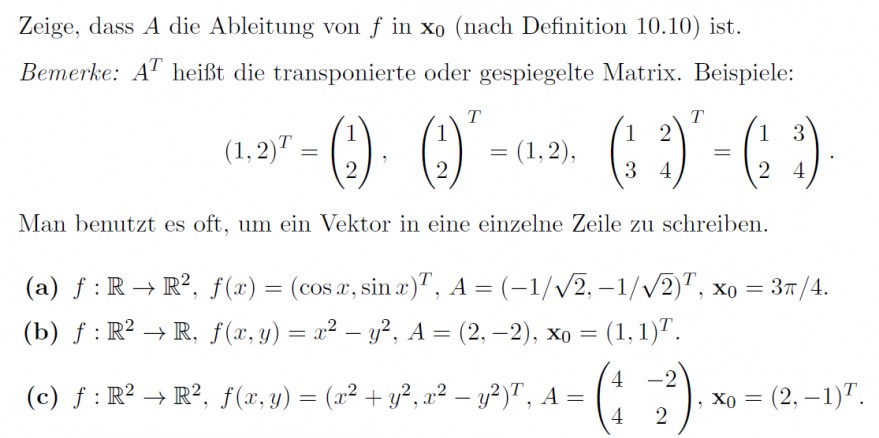Problem/Ansatz:

Text erkannt:
Zeige, dass \( A \) die Ableitung von \( f \) in \( \mathrm{x}_{0} \) (nach Definition \( \left.10.10\right) \) ist.
Bemerke: \( A^{T} \) heißt die transponierte oder gespiegelte Matrix. Beispiele:
$$ (1,2)^{T}=\left(\begin{array}{l} 1 \\ 2 \end{array}\right), \quad\left(\begin{array}{l} 1 \\ 2 \end{array}\right)^{T}=(1,2), \quad\left(\begin{array}{ll} 1 & 2 \\ 3 & 4 \end{array}\right)^{T}=\left(\begin{array}{ll} 1 & 3 \\ 2 & 4 \end{array}\right) \text { . } $$
Man benutzt es oft, um ein Vektor in eine einzelne Zeile zu schreiben.
$$ \text { (a) } f: \mathbb{R} \rightarrow \mathbb{R}^{2}, f(x)=(\cos x, \sin x)^{T}, A=(-1 / \sqrt{2},-1 / \sqrt{2})^{T}, \mathrm{x}_{0}=3 \pi / 4 . $$
(b) \( f: \mathbb{R}^{2} \rightarrow \mathbb{R}, f(x, y)=x^{2}-y^{2}, A=(2,-2), \mathrm{x}_{0}=(1,1)^{T} \).
$$ \text { (c) } f: \mathbb{R}^{2} \rightarrow \mathbb{R}^{2}, f(x, y)=\left(x^{2}+y^{2}, x^{2}-y^{2}\right)^{T}, A=\left(\begin{array}{cc} 4 & -2 \\ 4 & 2 \end{array}\right), \mathbf{x}_{0}=(2,-1)^{T} \text { . } $$
Ich hab die a) versucht zu machen jedoch weiß ich nicht wie ich weiter machen soll oder ob ich überhaupt richtig angegangen bin... Könnte jemand bitte helfen...
